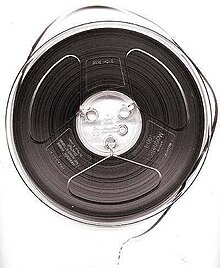
Back شريط مغناطيسي Arabic Cinta magnética AST Maqnit lenti Azerbaijani Магнитлы таҫма Bashkir Магнітная стужка Byelorussian Магнитна лента Bulgarian ম্যাগনেটিক টেপ Bengali/Bangla Magnetne trake BS Cinta magnètica Catalan Magnetická páska Czech

Magnetic tape is a medium for magnetic storage made of a thin, magnetizable coating on a long, narrow strip of plastic film. It was developed in Germany in 1928, based on the earlier magnetic wire recording from Denmark. Devices that use magnetic tape can with relative ease record and play back audio, visual, and binary computer data.
Magnetic tape revolutionized sound recording and reproduction and broadcasting. It allowed radio, which had always been broadcast live, to be recorded for later or repeated airing. Since the early 1950s, magnetic tape has been used with computers to store large quantities of data and is still used for backup purposes.
Magnetic tape begins to degrade after 10–20 years and therefore is not an ideal medium for long-term archival storage.[1] The exception is data tape formats like LTO which are specifically designed for long-term archiving.[2]
Information in magnetic tapes is often recorded in tracks which are narrow and long areas of information recorded magnetically onto the tape, which are separate from each other and often spaced apart from adjacent tracks. Tracks are often parallel to the length of the tape, in which case they are known as longitudinal tracks,[3][4] or diagonal relative to the length of the tape in helical scan.[5] There are also transverse scan and arcuate scanning, used in Quadruplex videotape. Azimuth recording is used to reduce or eliminate the spacing that exists between adjacent tracks.
- ^ Pogue, David (1 September 2016). "Digitize Those Memory-Filled Cassettes before They Disintegrate". Scientific American. Archived from the original on 19 August 2016. Retrieved 26 July 2022.
- ^ Coughlin, Tom. "LTO Tape Capacity Shipments Up In 2022". Forbes. Retrieved 19 December 2023.
- ^ Daniel, Eric D.; Denis Mee, C.; Clark, Mark H. (31 August 1998). Magnetic Recording: The First 100 Years. John Wiley & Sons. ISBN 978-0-7803-4709-0.
- ^ Anand, M. L. Audio and Video Systems. CRC Press. ISBN 978-1-040-14797-9.
- ^ Camras (6 December 2012). Magnetic Recording Handbook. Springer. ISBN 978-94-010-9468-9.